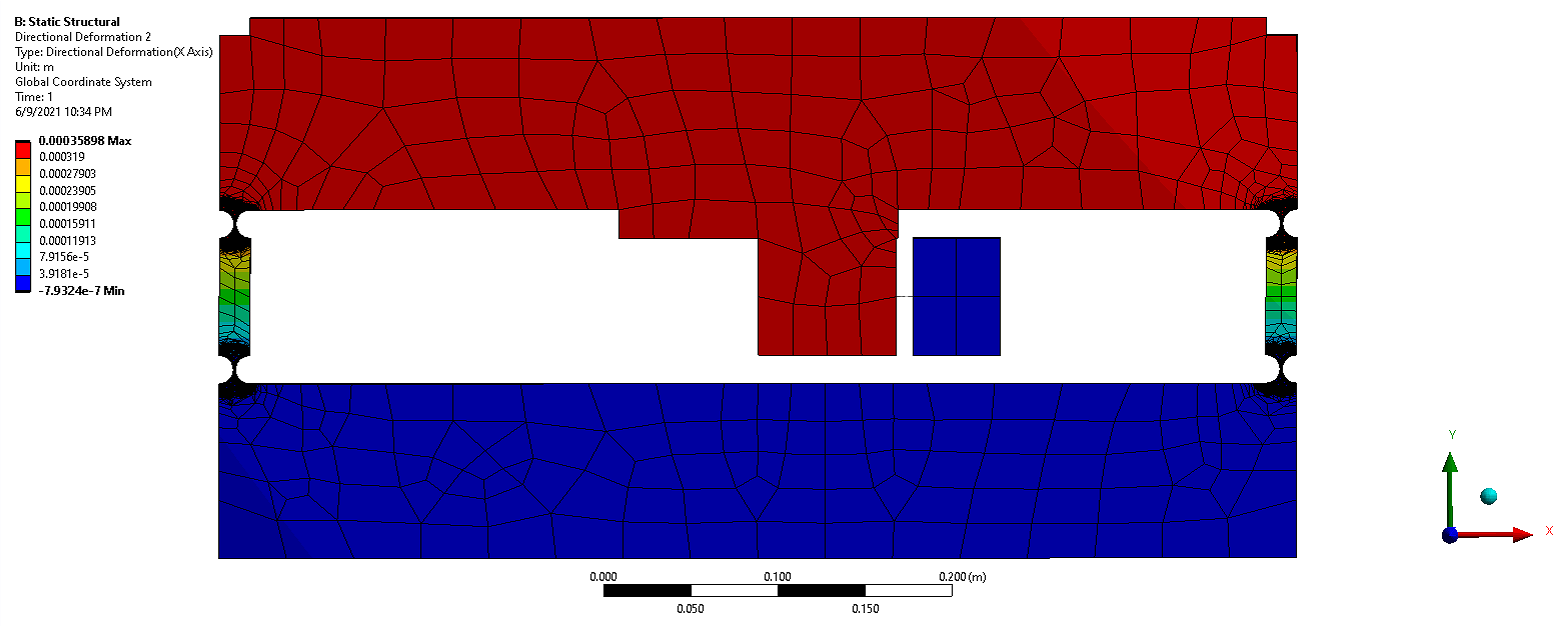TAGGED: ansys-workbench, deformation, mechanical, spring, static-structural
-
-
June 14, 2021 at 7:24 pm
heidipeterson
SubscriberI am modeling an aluminum flexure mechanism (4-bar linkage with notch hinges). I apply a horizontal force (1935 N) to the mechanism and measure the horizontal deformation in order to calculate the horizontal stiffness of the mechanism. In practice, there will be a load cell attached the mechanism, with a certain stiffness, that will apply an opposing force. I am modeling the load cell as a longitudinal spring between the mechanism and a separate solid, which I have tried to make rigid by adding a fixed support and choosing titanium as the material. I would like to measure the total stiffness of the system as well as the reaction force in the spring (load cell). I have created a Spring Probe to measure the force and elongation in the spring. I have created several Directional Deformations to measure the displacement of several parts of the mechanism. I have a few questions:
1. Is this the most correct way to model the load cell?
2. The elongation of the spring (from the Spring Probe) doesn't match (is less than) the deformation of the mechanism, specifically at the face where the spring is attached. How is this possible? What does the Elongation metric really mean?
3. The reaction force of the spring is greater than the force applied to the mechanism. This seems impossible. Am I misunderstanding the definition of the Elastic Force metric in the Spring Probe?
I have attached a photo of my setup and am happy to provide any other helpful info. Thank you very much for your help!
June 16, 2021 at 11:36 am1shan
Ansys Employee1) "I am modeling the load cell as a longitudinal spring...... titanium as the material" - You do not need a separate body to attach the spring. Change scope to "body ground", mobile as the deforming face/moving end of the spring and set suitable coordinates for the fixed end (reference).
2) Elongation is simply the change in length of the spring. It's possible that they may not exactly match because the spring is not horizontal when the deformation occurs and also in your case both ends where deforming.
3) "The reaction force of the spring is greater than the force applied to the mechanism. This seems impossible." - Why do you think its impossible? The only condition for equilibrium is net force and moment balance. You could use moment and force reaction probes to verify this.
Your mesh contains some highly skewed elements, which might lead to errors. You may want to use a finer mesh and improve the quality. You could do a mesh convergence study to check if its fine enough.
Regards Ishan.
Viewing 1 reply thread- The topic ‘Spring Probe Elongation doesn’t match structural Deformation (Mechanical: Static Structural)’ is closed to new replies.
Ansys Innovation SpaceTrending discussions- The legend values are not changing.
- LPBF Simulation of dissimilar materials in ANSYS mechanical (Thermal Transient)
- APDL, memory, solid
- Convergence error in modal analysis
- How to model a bimodular material in Mechanical
- Meaning of the error
- Simulate a fan on the end of shaft
- Real Life Example of a non-symmetric eigenvalue problem
- Nonlinear load cases combinations
- How can the results of Pressures and Motions for all elements be obtained?
Top Contributors-
3862
-
1414
-
1220
-
1118
-
1015
Top Rated Tags© 2025 Copyright ANSYS, Inc. All rights reserved.
Ansys does not support the usage of unauthorized Ansys software. Please visit www.ansys.com to obtain an official distribution.
-












